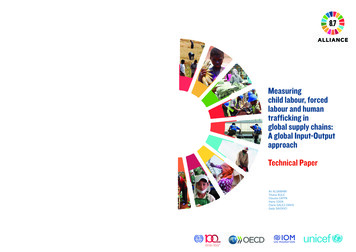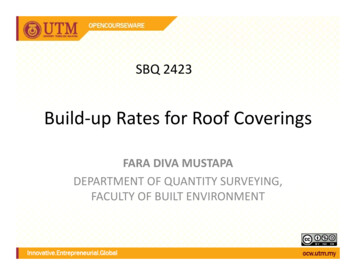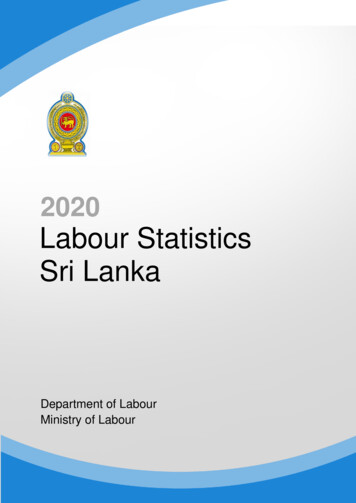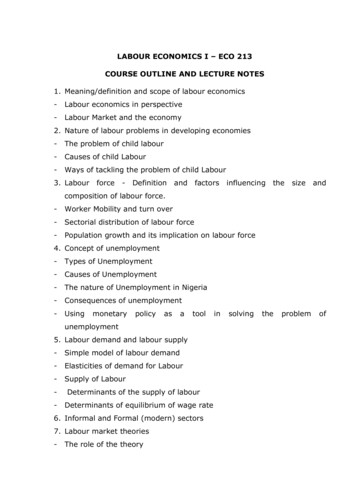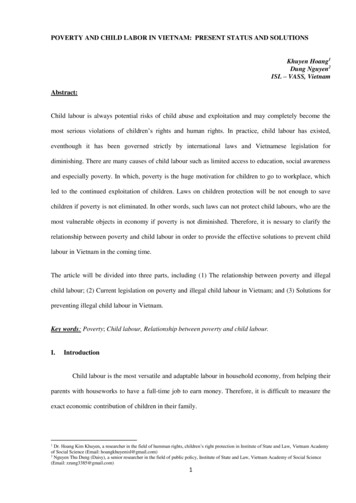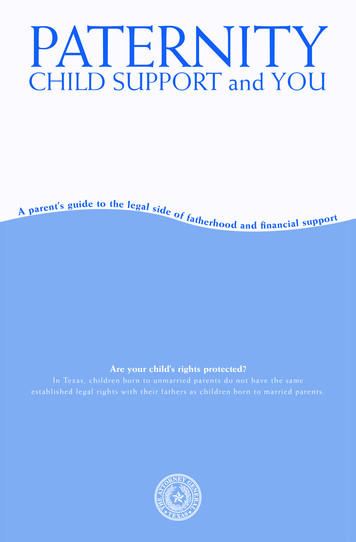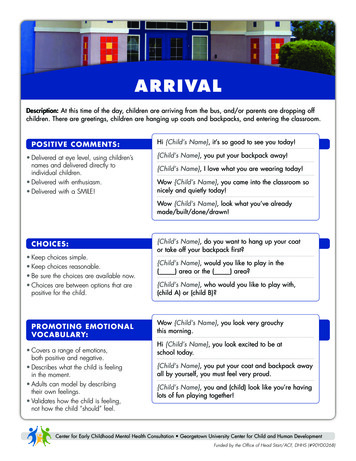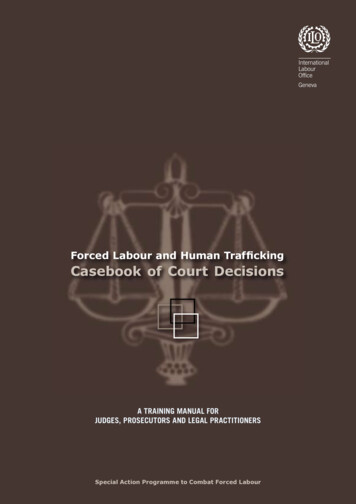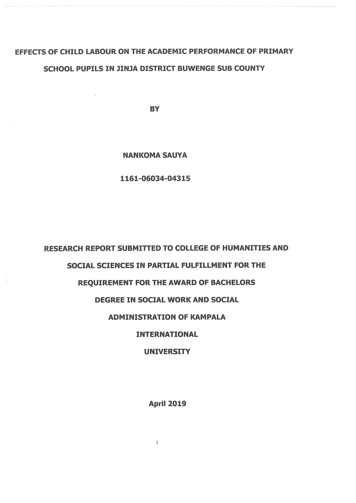
Transcription
EFFECTS OF CHILD LABOUR ON THE ACADEMIC PERFORMANCE OF PRIMARYSCHOOL PUPILS IN JINJA DISTRICT BUWENGE SUB COUNTYBYNAN KOMA SAUYA1161-06034-04315RESEARCH REPORT SUBMITTED TO COLLEGE OF HUMANITIES ANDSOCIAL SCIENCES IN PARTIAL FULFILLMENT FOR THEREQUIREMENT FOR THE AWARD OF BACHELORSDEGREE IN SOCIAL WORK AND SOCIALADMINISTRATION OF KAMPALAINTERNATIONALUNIVERSITYAprN 2019
DECLARATIONI declare to the best of our knowledge and understanding that this research reportunless otherwise stated is our original work and has never been submitted to any otherinstitution of higher learning for any award.Name. M. o XM cSign Date.j.
APPROVALThis is to certify that this research report under the title “Effects of Child Labour on theAcademic Performance of Primary School Pupils” has been done under my supervisionand I confirm that it’s ready for examination.SUPERVISORNameSignIIIDate
Tab e of ContentsDECLARATIONAPPROVALLIST OF TABLESviiiLIST OF ABBREVIATIONixABSTRACTCHAPTER ONES1INTRODUCTION11.0 Introduction11.2 Statement of the Problem21.3 Purpose of the Study41.4 Objectives of the Study41.4.1 General Objectives41.4 Research Objectives41.5 Research Questions41.6 Scope of the Studys1.6.1 Subject Scope51.6.2 Geographic Scope51.6.3 Time Scope51.7 Significance of the Study51.8 Conceptual Framework61.9 Definition of Terms7CHAPTER TWO8LITERATURE REVIEW82.0 Introduction82.1. Government Policy on Child Labour82.1.1 The National Child Labour Policyg2.1.2 The National Employment Policy2.1.3 Plan of Action on Child Labour102.2 Legal and Other Interventions to Eliminate Child Labour2.2.1 The Constitution of the Republic Of Ugandaiv1010
2.2.2 The Employment Decree 1975102.2.3 The Children’s Statute No. 16 of 1996102.2.4 Revisions Made To Labour Lawsii2.3 Practical Interventions112.3.1 The Ministry Of Gender, Labour and Social Development122.3.2 Universal Primary Education122.4 The Status of Working Children in Uganda122.4.1 Education in Uganda132.5 Child Labour and school performance152.6 Factors that Affect School Performance162.6.1 Teacher’s Characteristics162.6.2 School Administration172.6.3 Pupil’s Characteristics172.7 Measures to Curb Child Labour182.7.1 Legislation Framework182.7.2 ILO No 138 (1973)182.7.3 ILO Convention 182, 1999182.7.4 The Employment Act 2007192.7.5 ILO Recommendation 190, 1999192.7.6 The Children Act, 2001192.7.7 Complementary Interventions19CHAPTER THREES21RESEARCH METHODOLOGY213.0 Introduction213.1 Research Design213.2 Study Population213.2.1 Sample size213.3 Sampling Design and procedures223.4 Data Sources223.5 Data Collection Methods and Instruments233.5.1Questionnaires23V
3.5.2Interviews, 233.5.3Document Review233.6 Data Analysis243.7 Validity and reliability of instruments243.8 Data processing and analysis243.9 Ethical consideration253.10 Limitations of the Study25CHAPTER FOUR26PRESENTATION, ANALYSIS AND FINDINGS264.0 Introduction264.1 Socio Demographic Characteristics of the Respondents264.1.1 Gender264.1.2 Religion274.1.3 Level of education274.2 Child Labour Exposure274.3 Forms of Child Labour284.4 Effects of Child Labour on Academic Performance30CHAPTER FIVE34SUMMARY, CONCLUSIONS ANDRECOMMENDATIONS345.1 Introduction345.2 Summary of the Study345.3 Summary of Findings345.3.1 Forms of Child Labour345.3.2 Effects of Child Labour on Academic Performance355.3.3 Factors to improve academic Performance355.4 Conclusions of the Study365.5 Recommendations of the Study365.6 Suggestion for Further Research37REFERENCE38APPENDICES41APPENDIX 141vi
APPENDIX 2: Interview guide.46APPENDIX 3: Budget47APPENDIX 4: Time Frame48VII
LIST OF TABLES1 showing the gender2 showing the Religion3 showing the Level of education4 Distribution of Pupils base on labour Exposure5 Number of Pupils’ Working6 Pupils Responses on the Status of Employment they had7 Pupils Responses on Reason for Friends Dropping out of school8 Pupils responses on whether they got Homework9 Rating by Pupils of their Performance in Class10 Factors to improve academic PerformancevflI26272727282929303132
LIST OF ABBREVIATIONIPECInternational Program Elimination of Child LabourCRCThe Convention on The Rights Of The ChildUBOSUganda Bureau of StatisticsMOESTMinistry of education, science and TechnologyIRCThe International Rescue CommitteeAVSIAssociation of Volunteers in International ServiceLRAThe Lord’s Resistance unodeficiencySyndromeANPPCANAfrican Network for the prevention & prevention against child abuseand NeglectICDCIndustrial & commercial development CorporationILOInternational Labour OrganizationUNESCOUnited Nations Educational, Scientific& Cultural OrganizationUNUnited NationsUNICEFUnited Nation Children’s fundNGO’sNon-governmental OrganizationsWOFCLWorst Form of Child LabourWHOWorld health Organizationix
ABSTRACTThe purpose of the study was To identify the effects of child labour on the academicperformance of primary school children. The study was conducted in selected primaryschools in Buwenge Sub County Jinja District Eastern Uganda. The General Objectivesof the Study was To establish the effects of child labour on the academic performanceof primary school children in Jinja district Buwenge Sub County and the ResearchObjectives were; To find out the effects of child labour on the academic performance ofprimary school children in Jinja district Buwenge Sub County. To find out the effect ofchild labour on primary school children’s assessments grades in Jinja district BuwengeSub County. To find out the relationship between child labour and academicperformance in primary schools of Jinja district Buwenge Sub County.The researcher employed the simple random sampling technique during the researchwhen she selected the sample size of the research and here she employed bothqualitative and quantitative methods of data collection. The finding indicated that bothmale and females were respondents with the percentage of 100 this is true becausepupils and parents and head teachers were interviewed. The researcher used bothdescriptive and analytical research designs. The research designs were appropriatebecause data was easily analyzed using frequency counts and percentage derived fromthe responses obtained in the questionnaires. From the study, it’s clear that majority ofschool going children are agents of child labour and academic performance wasaffected due poor turn up and incomplete homework assignments from pupils. Inconclusion, Although high numbers of children from poor families are joining economicactivities as workers and continue to be exposed to various worst forms of child labour,the greatest challenge lays in unfolding its often invisible or disguised traits which makeit tolerable and widely accepted within local communities.x
CHAPTER ONE:INTRODUCTION1.0 IntroductionThis chapter introduces the background of the study, problem statement, purpose ofthe study research objectives and research questions,research hypotheses,significance, scope of the study, definition of terms and conceptual framework.1.1 Background to the StudyChild labor is a problem worldwide, but it particularly affects children in developingcountries. Child labor is characterized by full-time work at too early of an age, and toomany hours spent working. The work often exerts undue physical, social, orpsychological stress, hampers access to education, and may be detrimental to socialand psychological development.Child labour is a persistent problem found throughout much of the developing world,and to a lesser extent in developed countries. The International Labour Organization(ILO) estimates that around the world, 250 million children between the ages of fiveand fourteen years work and about 120 million of them full-time. Of the estimated 250million working children, 152 million (61%) are in Asia, 80 millionand 18 million(7%)(32%)are in Africain Latin America. Some of these children work in factories andother work places in the formal economy, but the vast majority work in informalenterprises, agriculture, and in homes (ILO-IPEC, 2013:17)The real awakening of developing countries to the distinction between child labour andchild work with child labour as a problem and a matter of public concern came in the1980s and 1990s with the advent of the Child Rights movement and the Child RightsConvention (1989).1
Whereas the likelihood of physical harm and injury and therefore, the physical andmental safety and health of children were the considerations that inspired the earlierconcern in industrialized countries, the post-1990 concern was driven by the concept of“Rights”.The fact that more than 80 years of ILO’s work and numerous Conventions have notsucceeded in abolishing child labour points to, not only its complexity and resilience butalso to the failure of interested parties to achieve consensus owing to seriousdifferences in perceptions, cultures and needs.Child labor is defined by Ugandan National Child Labor Policy as work that is hazardousor exploitative and threatens the health, safety, physical growth and mentaldevelopment of children. Even where the hazards are not immediately obvious such ascuts/disease exposure, they could include increased exposure to sexual, physical, oremotional abuse.Although it is illegal under both International and Ugandan laws to employ personsbelow the age of 18 in hazardous activities, there is little enforcement due to lack ofgovernment resources, and arguably a tolerant attitude towards child labor in manycommunities.1.2 Statement of the ProbilemChild Labour has long been identified as a problem in many countries both developingand developed. International and regional treaties namely; ILO Convention No.138(1973) on the Minimum Age for Admission to Employment, the ILO Convention No. 182(1999) on the prohibition of the Worst Forms of Child Labour, the UN Convention on theRights of the Child (1989) and the OAU Charter on the Rights of the Child have beenacceded to by Government. National laws notably the National Constitution 1995, theEmployment Decree No 4 of 1975 and the Children’s Statute 1996 have been put inplace to address child labour issues.2
Child Labour is often considered as a norm in those communities with a sizeable portionof the population having limited resources. In those communities, many children areexposed to risky and hazardous working conditions are exploited by being paid less andare subsequently denied a chance to get education thus affecting their future.Unfortunately, the children themselves do not have the opportunity to protest againstthese acts that are detrimental to their well-being. Moreover, given that many childrenwho are exposed to child labour are from poor and uneducated or orphaned families,the inability to protest is aggravated. Besides, many people do not understand thedangers and negative consequences of child labour. The situation has been worsenedby the HIV/AIDS pandemic, which has claimed lives of parents leaving orphans whohave to make a living for themselves.An estimate from the 2005 National Household Survey places the number of childworkers aged 7-14 at 2.2 million or 38.3% of children in that age group. This includes1.4 million children under the age of 12, and 735,000 children under the age of 10.Data from 12 Latin American countries find that third and fourth graders who attendschool and never conduct market or domestic work perform 28% better onmathematics tests and l9% better on language tests than children who both attendschool and work. Child labor is also problematic because it creates a vicious cycle.In many urban areas in Uganda, a number of children are employed as domesticworkers. These have been brought to towns by either their parents or guardians or,simply by themselves to make a living. Some of these children have ended up onstreets while others have engaged themselves in dangerous activities includingprostitution. Others have engaged themselves in dangerous activities in the urbaninformal sector. It is also believed that there is a lot of invisible child labour that isgoing on unnoticed especially in the rural areas.The International Conventions together with the country’s laws on child labour areattempts to address the problem including the worst forms of child labour. Althoughthere is growing concern for child labour, there is limited knowledge on the causes,effects and magnitude of the problem in Uganda. No extensive nation-wide survey has3
been conducted to study and examine and document the extent of child labour inUganda.L3 Purpose of the StudyTo identify the effects of child labour on the academic performance of primary schoolchildren.L4 Objectives of the StudyL4 1 Genera ObjectivesTo establish the effects of child labour on the academic performance of primary schoolchildren in Jinja district Buwenge Sub County.L4 Research Objectivesi.To find out the effects of child labour on the academic performance of primaryschool children in Jinja district Buwenge Sub County.ii.To find out the effect of child labour on primary school children’s assessmentsgrades in Jinja district Buwenge Sub County.iii.To find out the relationship between child labour and academic performance inprimary schools of Jinja district Buwenge Sub County.L5 Research Questions1. What are the effects of child labour on the academic performance of primaryschool children?2. In what extent does child labour effect primary school children’s assessmentsgrades and academic performance?3. What is the relationship between child labour and academic performance inprimary schools?4
1.6 Scope of the StudyThe study was concentrated on both positive and negative effects of child labour on theacademic performance of primary school children in selected primary schools inBuwenge Sub County Jinja district.1.6.1 Subject ScopeThe study was limited to the issue of child labour and academic performance of primaryschool children since it was too cumbersome to study all the factors that deteracademic performance of school children in the area.1.6.2 Geographic ScopeThe study was carried out in the selected primary schools in Buwenge Sub County, Jinjadistrict.1.6.3 Time ScopeThe study lasted for a period of five months, starting from February to June 2019.1.7 Significance of the StudyIn a society where children’s academic performance in most public schools is gettinglower, many research studies have been carried out outside the effects of child labouron the academic performance of primary school children. There is need therefore forsuch a study to be carried out in our locality with different cultural settings. The resultof this study was an added advantage to governments stand on child’s right act andcare, if it shows a significant influence. Parents, Guardians, Teachers, other caregiversand the general public found the result of this study useful, as it revealed to them theneed for effective care and protection of their children, especially the importance ofproviding educational needs for a higher academic performance. The research was alsoa resource of value to other researchers carrying out research on the topic or similarsubject matter.5
L8 Conceptual FrameworkThe conceptual frame work below shows the linkages between the independentvariables and intervening variable affect with dependent variable. Parental socioeconomic status the income levels and Education levels are independent variableswhich can cause a change to the performance of children in school. Ineffectiveenforcement of legal provisions on children is an intervening variable in which a successof it will reduce the levels of child labour and consequently reduce on the dependentvariable which is performance in class.Figure 1: A conceptual framework showing how sets of independent andintervening variables influence child performance in classIntervening VariablesIndependent VariablesDependentVariableParental Social economicstatusParental IncomeEducation levels of theIgnorance of theconsequences of childlabourNon-availability and/orinaccessibility to schoolsNchild Labour- Side Effects of childLabouroKIIneffectiveenforcementof legalprovisions onchildcompulsory EducationSource: self-initiated6ooLateness inschoolAbsenteeismLack ofconcentrationin schoolIPerformancein class
1.9 Definition of TermsThe following words and phrases are been defined or given explanations as used in thiswork. Thus, they are put to the scale of contextual meaning. However, the researcherstrives as much as possible not to deviate totally from their conceptual meanings.A Child: A child is any person under the age of 18 years.Child abour: Child is said to be given labour when the parents, care givers or anyhuman action leads to physical, emotional, spiritual mistreat of the child. It also involvesfailure of the parents to provide the necessary love and care for the child.Academic Performance: Academic performance is the outcome of education; theextent to which a student has achieved his/her educational goals. It may also refer to aperson’s strong achievements in a given academic arena. Thus, it is sometimes calledproficiency and may be quantified in several ways, such as exams and tests. In a giventerm or session, high academic performance may mean a student is on the honor roll.7
CHAPTER TWO:LITERATURE REVIEW2.0 IntroductionThis chapter will review the literature by different researchers and scholars on effects oftaxation policies on performance in small and medium enterprise. The aim is to analyzethe existing literature on the subject in order to reveal contribution, weakness andhighlight factors that influence taxation policies on performance in small and mediumenterprise.2.L Government Policy on Child LabourIn Uganda, any person below the age of 18 years is considered to be a child. However,throughout this document, reference was made to children in the age bracket of 5-17years for which UDHS collected information. Like in many societies in Africa, Ugandanchildren are expected to perform several tasks as they progress to adulthood under theprinciple of preparing them to be good adults, what is generally referred to associalization.Light tasks such as cooking, washing, and fetching firewood, if done in moderation andin consideration of the capacity of the child’s other rights, in particular, the right toeducation, are acceptable as a process of living and a means of transmitting skills fromparent to child.However, tasks that place children in danger or expose them to unhealthy, dirty,strenuous moral and exploitative conditions are not acceptable. This is the type of childlabour that government is concerned about. A number of interventions have been madeto address this phenomenon.8
2.1.1 The Nat onall Child Labour PohcyThe Ministry of Gender, Labour and Social Development, Labour and SocialDevelopment is in the process of formulating a national policy on child labour. Thepolicy identifies and enumerates the socio-economic context of child labour in Uganda,the nature, extent and magnitude of child labour, the causes and consequences andeffects of child labour, government response and milestones achieved, strategies forimplementation and the institutional framework within which the national child labourpolicy will operate.The national child labour policy identifies the worst forms of child labour based on datagenerated from various studies supported by ILO-IPEC’ and other developmentpartners and include: children engaged in commercial agriculture especially in sugarplantations, children engaged in fishing along the lake shores and in the islands,children in domestic labour, children in the informal sector, street activities andcommercial sexual exploitation, children in armed conflicts and children in theconstruction sector.2.1.2 The NaUon& Emp oyment PoilcyThe National Employment Policy being drafted is an attempt by government toformulate a comprehensive policy on employment. The employment policy emphasizesthe importance government attaches to the protection and promotion of employmentopportunities. Furthermore, given the multi-dimensional nature of the employmentsituation in the country, its contribution to the poverty reduction efforts need not beover emphasized. The objectives of the employment policy are among others to:oPromote the goal of full employment,oSecure improvement in the productivity of labour,oProvide the fullest opportunity to each worker,oSafeguard the basic rights and interests of workers andoStimulate economic growth and development.9
The Employment policy sets out the principles and strategies and, the institutionalframework for the implementation of the employment policy.2 L3 Plan of Action on Child LabourThe Draft plan of action on the elimination of child labour was adopted by the NationalSteering Committee and has been disseminated to districts. The Child Labour Unit ofthe Ministry of Labour, Gender and Social Development (MGLSD) is making follow-upsat national and district level.2 2 Legal and Other Interventions to Eliminate Child Labour2 2 1 The Constitution of the Republic Of UgandaThe Uganda Constitution 1995 (Chapter 1, Article 34 (4)) provides for the protection ofa child from hazardous and exploitative work. The constitution clearly spells out thefollowing rights of children;Children are entitled to be protected from social and economic exploitation and shallnot be employed in or required to perform work that is likely to be hazardous or tointerfere with their education or to be harmful to their health or physical, mental,spiritual, moral or social development.2 2 2 The Employment Decree 1975There exists the employment decree of 1975 that limits employment of childrenbetween 12- 18 years and prevents (or prohibits) it for children below 12 years (Part IVSection). The decree however, restricts employment for those aged between 12 and 18years and empowers labour inspectors to monitor compliance.2.23 The Children’s Statute No 16 of 1996The Children’s Statute 1996 spells out the right of a child and the welfare principles thatguide those under care for children Part 2, Section 9 states “A child has a right not tobe made to work or take part in any activity whether for pay or not which is likely toinjure the child’s health, education, mental, physical or moral development. For10
example, all children have to help out in household work, but they must do soaccording to their age and ability”. In addition a child in Uganda has a right to thefollowing:oA right to live with his or her parents. Provision is also made in instances wherethe child and parent are separatedoRight to education and guidanceoRight to be protected from violence, ill-treatment and any behavior that mightshow a lack of care or interest in childoRight to be protected from any form of discriminationoRight to be protected from any social or customary practices that are dangerousto the child’s healthFor children with disabilities, the state shall have duty to have the child examined tofind out the extent and type of disability and thereafter, the child shall then be givenfacilities to help him/her live as normal a life as possible.The above rights have been widely disseminated through several agencies like NationalCouncil for Children, Children agencies and Non-Governmental Organizations.2.2.4 Rev s ons Made To Labour LawsThe Employment Decree of 1975 and three other Labour Laws have been revised sothat they are in line with the principles of the ILO Convention Nos. 138 and 182. Therevision takes care of the prohibition of persons below the age of 18 years fromworking in hazardous and injurious work. In addition, the minimum age of admission toemployment has been set at 14 years.2.3 Practka InterventionsGovernment through the Ministry of Gender, Labour and Social Development hasinitiated a number of interventions in form of policies and has also set up institutionsthat are directly and indirectly aimed at eliminating child labour. These include but arenot limited to Universal Primary Education (UPE), Poverty Eradication Action Plan11
(PEAP), and National Council for Children (NCC) and the Child Labour Unit in theMinistry of Gender, Labour and Social Development, (MGLSD).2 3 1 The Ministry Of Gender, Labour and Social DevelopmentThe Ministry of Gender, Labour and Social Development (MGLSD), is mandated to dealwith employment and occupational health and safety at work places and labourmatters. A National Steering Committee on Child Labour has been constituted with theMGLSD providing the secretariat. In addition, MGLSD is the Government Ministryhousing the child labour unit. The major task of the Unit is to advocate for theelimination of child labour and the promotion of general public awareness of nationalpolicies on child labour. Another sister department in the same ministry is responsiblefor advocating for the rights of children. The labour legislation is currently under reviewand is expected to become law soon.2.3.2 Universal Primary EducationThe Universal Primary Education (UPE) implemented since 1997 is the chiefgovernments’ education priority program. The UPE program aims among other things atenhancing enrollment and retention of children in primary schools and improvingattendance and making instructional time more effective. The program has multipronged benefits especially to vulnerable children at the risk of engaging in child labouras listed below:First, the provision of free primary education delays and discourages children fromentering the labour market at an early age,Second, children with disabilities have an opportunity to access free primary educationthat draws them away from vulnerable circumstances like streets and isolation.2.4 The Status of Working Children in UgandaIn Uganda, the status of working children is not well documented. However, the 1991Population and Housing Census enumerated about 3.3 million children in the 10-17 yearage bracket. This number has certainly increased during the last decade because of the12
natural growth related to the high fertility sighted above. According to the 1997 pilotlabour force survey (table 2.5 refers), more than 140,000 children aged 7 —17 yearswere estimated to be employed while more than 100,000 other children were notworking.Table 2.1 Working children by age, sex and current activity status Uganda (‘000)Current activity Status-Current activity StatusAge-groups7-12Male13-17FemaleTotalMaleFemale 9.857.651.5109.0Students1,325.4 1,308.32,633.6 .117.736.8983.32,100.0Employer & own account 2.9workersUnpaid family Workers EmployeesUnpaiddomesticwks. 67.8(housekeepers)Othernoteconomically 111.8active personsTotal1,838.3 1,824.03,662,4 1,117.1Source: 1997 Pilot Labour Survey ReportNote: Figures have been rounded off to the nearest 1002.4 1 Education in UgandaEducation is one of the key sectors that government is targeting for poverty eradication.The benefits derived from education to the individual in particular and the countries ingeneral are enormous and play a crucial role in any country’s development. The formal13
education system in Uganda consists of primary, secondary, higher and Universitylevels. There is an examination that qualifies a candidate to move from one level toanother level. A candidate may join an institution after the completion of any levelabove primary. Primary level requires 7 years of schooling before one sits for exams,secondary school level requires 4 years but with an examination at the end of thefourth year before a candidate qualifies for higher school, the two years pre-universityentrance.Government has implemented programs and policies that favor the growth of theeducation sector. The liberalization policy together with the Universal Primary Education(UPE) have increased enrollment especially in primary schools from 2.7 million pupils in1997 to 6.5 million in 2000 (figure 2.1 refers).Secondary school enrollment realized a 79 percent increase between 1996 and 2000.This represents an annual average of about 16 percent. The increase in secondaryschool enrollment however, is much lower than that of primary education andsignificant increases are expected as more primary graduates join secondary schools.Table 2.2 Secondary School enrollments Q000’) 55427519Source: 2001 Statistical AbstractThe implementation of UPE will inevitably increase the demand for secondaryeducation. The Government policy of Universal Primary Education and increasedsecondary enrollment will reduce chances of children aged 5-17 years getting involvedin child labour14
2.5 ChHd Labour and scho& performanceAccording to Soares (2002), the determinants of students’ academic progress can beclassified into three groups of variables: those related to students’ individual and familyCharacteristics, those related to the socioeconomic context of the school, and thoserelated to the processes and pedagogical practices of schools. The relationshipsbetween child labour and schooling involve interlinking factors therefore the direction ofcausation can go either way. Child labour affects schooling, but poor performance inschool might also impact child labour. Poor school quality and the indifference offamilies and students to school might cause students to enter earlier into the labourmarket.Factors that affect both child labour and school achievement occur at the levels ofindividuals, families, schools, and communities and include school availability, schoolinfrastructure, parents’ education, family income, individuals’ natural abilities for school,community labour market conditions, and low levels of parental participation in theirchildren’s education and in their communities (Barros and
2.2.2 The Employment Decree 1975 10 2.2.3 The Children's Statute No. 16 of 1996 10 2.2.4 Revisions Made To Labour Laws ii 2.3 Practical Interventions 11 2.3.1 The Ministry Of Gender, Labour and Social Development 12 2.3.2 Universal Primary Education 12 2.4 The Status of Working Children in Uganda 12 2.4.1 Education in Uganda 13 2.5 Child Labour and school performance 15
